ARTISTS ARE OVERACHEIVERS
by
LYDIA SCHRUFER
______________
It
is the rare the artist who can earn his/her living from art
and must, therefore, find gainful employment. Lucky are artists
who have careers in creative, art related fields; and while
many don’t, they still find time and energy to pursue
their creative impulses.
I
am a member of AXIAL, which is a group of eight dedicated, hard
working artists. We get together once a month to critique one
another’s work, discuss the many subjects and issues that
are usually only of interest to artists, share gallery and exhibition
news, and round out the meeting by sharing gourmet tidbits and
the wine supplied by each member of the group. At our last gathering,
lulled by good company and good wine, I realized that we had
all taken time out of our very busy lives, rescheduled meetings,
commitments to family, and regular jobs to be with like-minded
people who share a passion for making art. Most of our members
work or have worked at other professions, while simultaneously
creating and exhibiting their art work.
William
Kinnis, in his 80s, and Dominique Mousseau Tremblay, in mid
career, are members of AXIAL, and are both examples of overachieving
artists. Despite our popular lament about the lack of time for
family sit down dinners, no time to exercise or read a book
-- the list is endless – we do what artists must do: find
the time and energy to pursue our passion. Dominique has found
time to do all of the above and much more. He is the newest
member of AXIAL and I asked him to share some of his insights
about managing a career, family and his prolific art production
since time management is a frequent subject for discussion among
working artists.
I
begin with an interview of Dominique Mousseau Tremblay and then,
in his own words, William Kinnis recounts his remarkable life
in art.
LYDIA SCHRUFER: Dominique, tell me a little bit about your background;
where did you go to school?
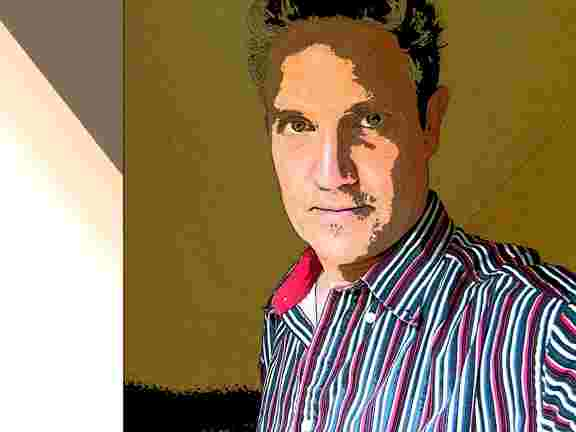 DOMINIQUE
MOUSSEAU TREMBLAY: Our nomadic family moved a lot. From the
luminous and luscious East-Africa, where I was born, to the
dark, cold and sombre city of Ottawa where I daydreamed through
elementary school. From the Rideau canal, we moved to the heights
of Ste-Foy, a suburb of Québec city where I “completed”
my secondary school stumbling from grade to grade; I was more
interested in playing every sport I could handle, especially
hockey. Art wasn’t on my mind until my CEGEP years. Didn’t
even know you could make a career selling your own art. Came
back to Ottawa, subscribed to a commercial art course at Algonquin
College, completing the program back in the Québec City
area at Limoulou College. Moving to the next level, I obtained
a Baccalaureate in “Communication Visuel” at Université
Laval. It wasn’t what I was aspiring to but, I admit,
I gave in to peer pressure. I then found work as an illustrator
and designer for several publicity agencies.
DOMINIQUE
MOUSSEAU TREMBLAY: Our nomadic family moved a lot. From the
luminous and luscious East-Africa, where I was born, to the
dark, cold and sombre city of Ottawa where I daydreamed through
elementary school. From the Rideau canal, we moved to the heights
of Ste-Foy, a suburb of Québec city where I “completed”
my secondary school stumbling from grade to grade; I was more
interested in playing every sport I could handle, especially
hockey. Art wasn’t on my mind until my CEGEP years. Didn’t
even know you could make a career selling your own art. Came
back to Ottawa, subscribed to a commercial art course at Algonquin
College, completing the program back in the Québec City
area at Limoulou College. Moving to the next level, I obtained
a Baccalaureate in “Communication Visuel” at Université
Laval. It wasn’t what I was aspiring to but, I admit,
I gave in to peer pressure. I then found work as an illustrator
and designer for several publicity agencies.
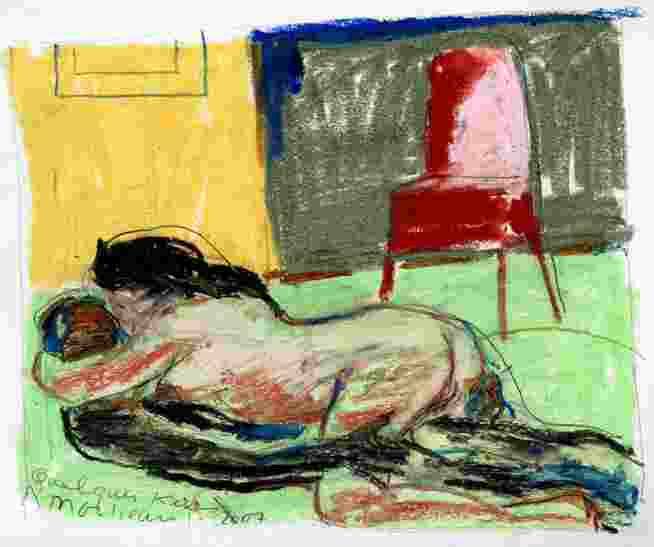
LS:
I know that you have an eleven year old son and are working;
can you tell me a little bit about how much time you have to
devote to your responsibilities.
DOMINIQUE
MOUSSEAU TREMBLAY: Life changed course when my son was born.
Years before his birth, I had quit my profession to fulfill
my big dream, living as an artist. At least trying hard to make
it in Montréal. Part time day jobs provided for necessities
and art expenses. La vie de bohème. But when
my son was announced, anxiety got hold of me. My life as a bohemian
wasn’t going to be enough to offer decent place for him.
I didn’t have the kind of ego that would let me forget
my responsibility to my son. I stored the paint brushes, paints,
canvases, papers, and frames and went back to school to study
graphic computer design. That was the big thing then when software
was starting to be more user friendly. Another diploma later,
I took a job, with a regular pay check, as an infographe. I
then bought a modest home, and organized my life around parenting.
To facilitate the task, my employers, Dieu merci, let me work
from home.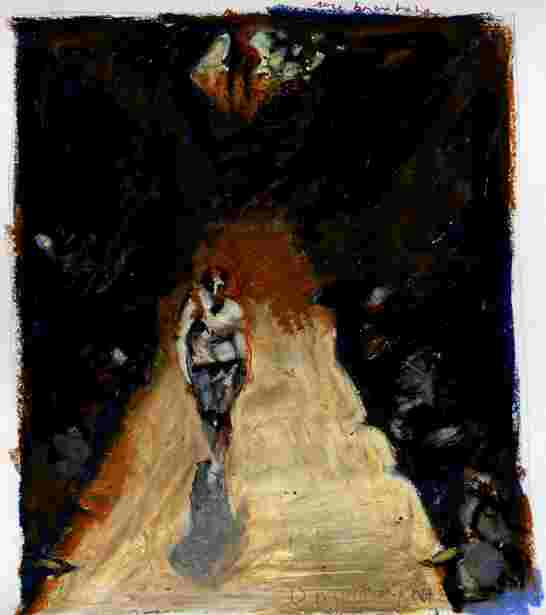
I
now have my son in garde partagé, making it
much harder to find time for art projects. Transportation between
houses, being the main activity.
LS:
Have you always made time to work at your art?
DOMINIQUE
MOUSSEAU TREMBLAY: Even if I stored my art tools, I always found
ways to produce work. In smaller dimensions, on paper, using
pencils, watercolours and oil pastels. They were fast to produce.
The knowledge of computers and software opened a whole new world
for creating digital art. The purchase of a camera was a marvellous
and handy instrument to capture ideas, moments. Storing the
pictures on hard drives made it easy to archive the images by
themes for future use.
LS:
You are an experienced prolific artist. What was the most difficult
aspect of balancing your various commitments? Were there times
when you felt overwhelmed?
DOMINIQUE
MOUSSEAU TREMBLAY: The love of my son made it easy for me. It
was natural for me to take care of him. I never felt overwhelmed.
Educating a child is an added experience to my life. I didn’t
want to miss having a child and thereby see the world from a
wider lens. Through his eyes are reflections of another space
to discover. I know that I will open that storage room, install
the equipment to produce larger and more flamboyant work once
the boy grows up.
LS:
Do you draw inspiration from your family and career?
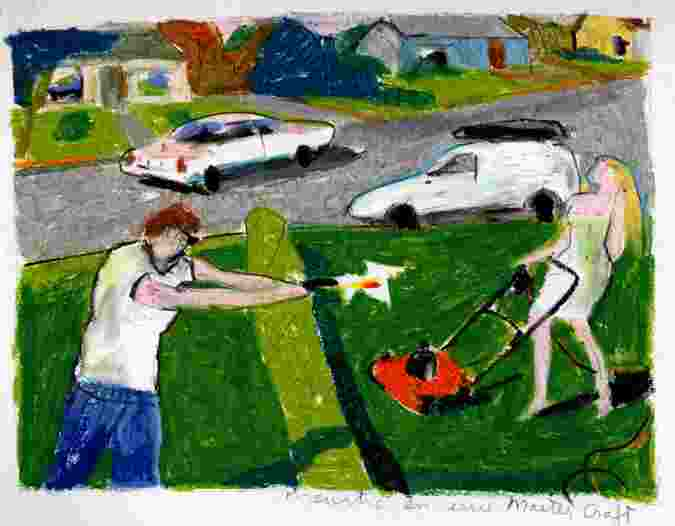 DOMINIQUE
MOUSSEAU TREMBLAY: Inspiration comes from everything and everywhere.
Going back to your previous question, if I’m overwhelmed
by something it’s inspiration. It surges from many sources.
Sometimes I think it’s too much of a good things: from
family to lovers to people on the streets. Moods, atmosphere,
other artists, music, architecture, urban and rural landscapes
-- all these elements enrich my vision.. International politics
weigh heavily on my mind and also find their way into my art
as does climate change, injustice and poverty. I love to explore
the wide spectrum of mankind’s often strange behaviour.
DOMINIQUE
MOUSSEAU TREMBLAY: Inspiration comes from everything and everywhere.
Going back to your previous question, if I’m overwhelmed
by something it’s inspiration. It surges from many sources.
Sometimes I think it’s too much of a good things: from
family to lovers to people on the streets. Moods, atmosphere,
other artists, music, architecture, urban and rural landscapes
-- all these elements enrich my vision.. International politics
weigh heavily on my mind and also find their way into my art
as does climate change, injustice and poverty. I love to explore
the wide spectrum of mankind’s often strange behaviour.
LS:
Do you have a favourite place or time in which you find it easier
to make time for your art work?
DOMINIQUE
MOUSSEAU TREMBLAY: Recently I was caught up at the US border
coming back to Canada. Since 9/11, agents are more vigilant
and ask more questions, make you open your trunk and generally
take their time; there were fifty cars were in front of me.
So I took out my pad and started drawing and before I knew it,
“Anything to declare?” I was in Canada. I can sketch
in buses, metros, even while biking, but the best place to work
is still at my parent’s cottage in Vermont by lake Champlain.
The cottage looks east towards the Adirondacks. That’s
my favourite place, at around 5 in evening when when the sun
reflects on the lake and spreads endless panoramas served on
a golden platter. These are the unique moments that need to
be seared onto paper and into memory.
LS:
Besides good health and remarkable stamina, do you have any
advice about how to manage a career, family and art?
DOMINIQUE
MOUSSEAU TREMBLAY: Anxious as I am, I need to be autonomous
and free of the obligation to sell my art work for a living.
I don’t want to rely on any government or family to manage
my life. I also refuse to pin my hopes on any eventual art success.
A career gives me peace of mind and the reassurance to care
for the ones I love. As for art, well it’s always there,
it’s in everything I do. I’m always guided by the
impulse to create art.
*
* * * * * * * * *
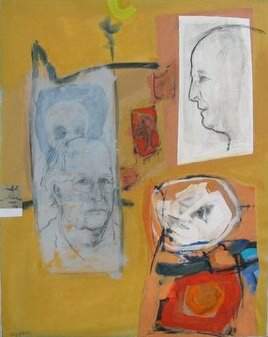 The
impulse to create is also what drives William -- Bill to his
friends -- Kinnis. In his own words: “For three years,
beginning in 1940, I was able to attend an art school in Vancouver;
and for the first time in my life being a student wasn’t
fearsome. The very thing I had a talent for was made available
and I grabbed the opportunity because the little town I grew
up in didn’t offer much in the visual arts. B. C. Binning
and Jack Shadbolt were two notable teachers at the school. My
parents had looked into the possibility of my going to London
to study, since I had relatives there but the outbreak of war
made that impossible.
The
impulse to create is also what drives William -- Bill to his
friends -- Kinnis. In his own words: “For three years,
beginning in 1940, I was able to attend an art school in Vancouver;
and for the first time in my life being a student wasn’t
fearsome. The very thing I had a talent for was made available
and I grabbed the opportunity because the little town I grew
up in didn’t offer much in the visual arts. B. C. Binning
and Jack Shadbolt were two notable teachers at the school. My
parents had looked into the possibility of my going to London
to study, since I had relatives there but the outbreak of war
made that impossible.
“By
1943 I’d learned enough to get work in an aircraft plant,
making illustrations of aircraft parts, but by the end of that
year I was in Ottawa with the National Film Board in the graphics
department. What I learned at the NFB about the commercial arts
would later stand me in good stead in Montreal. Life in the
war-time capital was interesting in that I worked on war propaganda
and on a social planning project for peace. I married Gladys,
a writer, in Ottawa and arrived in Montreal in the spring of
1947. I was employed at a printing plant, but I was also painting
and getting to know other artists, one of them being Louis Muhlstock.

“Once
a week we had the use of an old architect’s studio building
on Beaver Hall Square, where we would draw from the model. Great
times we had! We used the space for several years, and then
Gladys and I took it over and lived there for six or seven years
until it was torn down. Surviving in the city wasn’t easy
but we managed to keep a certain amount of independence and
in 1949 I gave up the printing job to go back to school. I justified
the decision by saying I’d learn to paint murals instead
of sitting at a desk. At the Museum of Fine Arts School, I had
two teachers, Jacques de Tonnancour and Goodridge Roberts, whose
work appealed to me. Their character and personality had a strong
effect on me as a painter. During this time Gladys was working
and earned a BA in social work.
“At
the end of the year at school Arthur Lismer told us; “Don’t
figure on making a living at painting. Teach . . . teach the
great unwashed.” I began teaching, as many were doing:
Alfy Pinsky and John Fox among them, and one of the perks was
being able to use my studio for a while. I soon began giving
regular classes at the YWCA and at other places around the city,
and since most of the classes took place in the evening I did
some free-lance work such as touching up photographs. Gladys
worked at several agencies and later at the Allan Memorial Hospital
after earning an MSc. on a bursary.
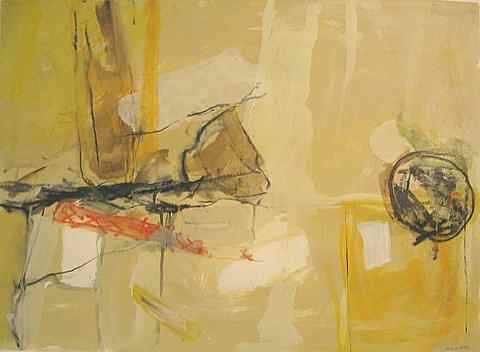
“Summer
months of 1952 were spent in the country at a cottage in Baie-St.Paul,
which two art school friends had built themselves. We were so
enthralled with their life style that the following year we
decided to build our own cottage. Teaching and free-lance work
allowed me the freedom to be away from the city during summer
and prices of land and materials were very reasonable. By saving
during the year and finding a tenant to take over the studio
we were able to stay at the cottage for some time every summer.
I’ll never forget our days living in a most scenic part
of Quebec, and although we never did have electricity or water
piped in, we did have a small river and we were young and didn’t
mind living a bit rough.
“One
day Goodridge Roberts was visiting and we were going out to
paint. I headed for the car but he had turned in the other direction
and set up his easel, quite satisfied with a subject that I
passed almost every day. It turned out to be one of his best
works and I learned that one doesn’t have to go far --
the subject is right before you.
“By
the sixties we had four children and our directions were changing.
We were both to have full time jobs and a shorter commute to
a summer retreat. Two art directors at The Gazette helped me
from the earliest times by taking me on staff after each summer,
which for the twenty or so years that I worked there allowed
me to draw a pension when I retired. We also bought a summer
house in Sutton, much closer to Montreal, and we’ve spent
summers there ever since. Needless to say I didn’t get
as much painting done during those years, but I did continue
to teach art, including a period teaching drawing at Concordia
University’s continuing education program while exhibiting
in Toronto, Windsor and Hamilton. My Paintings are part of collections
in Canada, USA, England and Australia. I’ve also continued
exhibiting solo or in group shows since the 1950s and am still
doing so. My work has changed and evolved and since 1984 after
a session at Sayde Bronfman School, I learned to love acrylic
paint which I have been using ever since. My work has become
more abstract and now allows a complete reliance on an inner
resource that I hadn’t been using to its fullest. I feel
more pleased with the results.”
Thank
you both, Dominique and Bill, for taking yet more time to share
some of your thoughts with me, and all the other dedicated overachievers,
in all the creative fields from painters to poets. Take a bow
and pat yourselves on the back and keep creating.